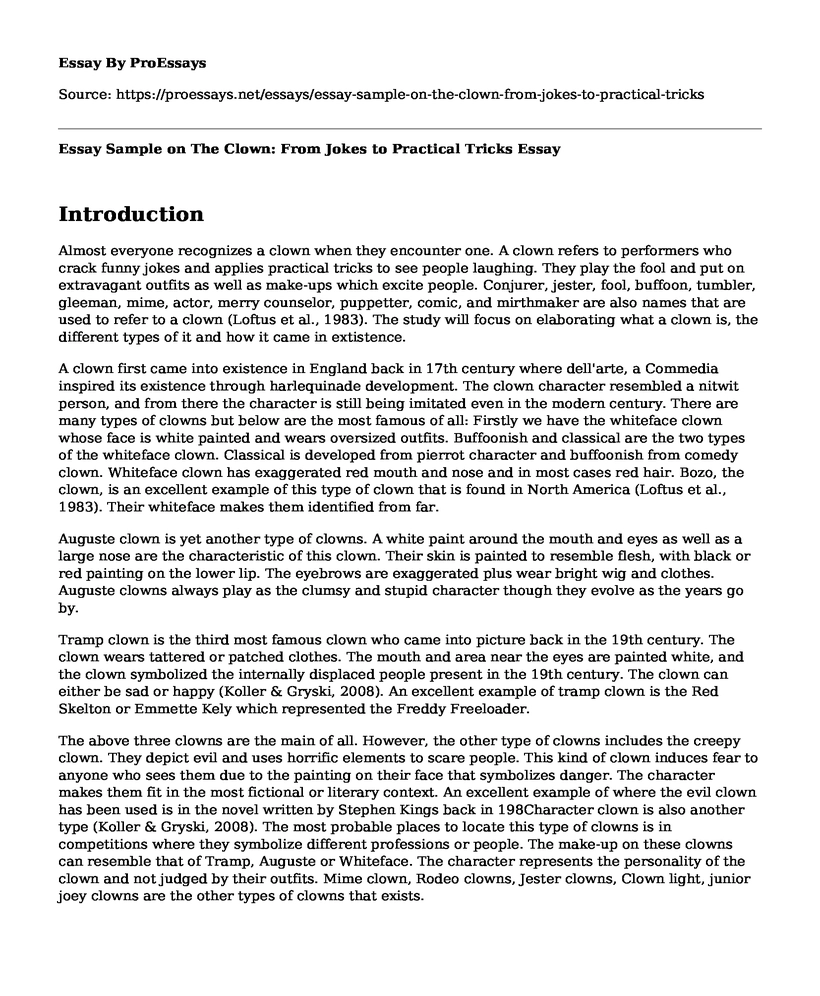Introduction
Almost everyone recognizes a clown when they encounter one. A clown refers to performers who crack funny jokes and applies practical tricks to see people laughing. They play the fool and put on extravagant outfits as well as make-ups which excite people. Conjurer, jester, fool, buffoon, tumbler, gleeman, mime, actor, merry counselor, puppetter, comic, and mirthmaker are also names that are used to refer to a clown (Loftus et al., 1983). The study will focus on elaborating what a clown is, the different types of it and how it came in extistence.
A clown first came into existence in England back in 17th century where dell'arte, a Commedia inspired its existence through harlequinade development. The clown character resembled a nitwit person, and from there the character is still being imitated even in the modern century. There are many types of clowns but below are the most famous of all: Firstly we have the whiteface clown whose face is white painted and wears oversized outfits. Buffoonish and classical are the two types of the whiteface clown. Classical is developed from pierrot character and buffoonish from comedy clown. Whiteface clown has exaggerated red mouth and nose and in most cases red hair. Bozo, the clown, is an excellent example of this type of clown that is found in North America (Loftus et al., 1983). Their whiteface makes them identified from far.
Auguste clown is yet another type of clowns. A white paint around the mouth and eyes as well as a large nose are the characteristic of this clown. Their skin is painted to resemble flesh, with black or red painting on the lower lip. The eyebrows are exaggerated plus wear bright wig and clothes. Auguste clowns always play as the clumsy and stupid character though they evolve as the years go by.
Tramp clown is the third most famous clown who came into picture back in the 19th century. The clown wears tattered or patched clothes. The mouth and area near the eyes are painted white, and the clown symbolized the internally displaced people present in the 19th century. The clown can either be sad or happy (Koller & Gryski, 2008). An excellent example of tramp clown is the Red Skelton or Emmette Kely which represented the Freddy Freeloader.
The above three clowns are the main of all. However, the other type of clowns includes the creepy clown. They depict evil and uses horrific elements to scare people. This kind of clown induces fear to anyone who sees them due to the painting on their face that symbolizes danger. The character makes them fit in the most fictional or literary context. An excellent example of where the evil clown has been used is in the novel written by Stephen Kings back in 198Character clown is also another type (Koller & Gryski, 2008). The most probable places to locate this type of clowns is in competitions where they symbolize different professions or people. The make-up on these clowns can resemble that of Tramp, Auguste or Whiteface. The character represents the personality of the clown and not judged by their outfits. Mime clown, Rodeo clowns, Jester clowns, Clown light, junior joey clowns are the other types of clowns that exists.
Conclusion
In conclusion, clowns are characters who dress in a way that provokes laughter to people. Whiteface, Auguste and Tramp are the three major types of clowns as explained above though there are a number of them. However, not all clowns that bring laughter to people because some like the creepy crown bring phobia due to their appearance.
References
Koller, D., & Gryski, C. (2008). The life threatened child and the life-enhancing clown: towards a model of therapeutic clowning. Evidence-based complementary and alternative medicine, 5(1), 17-25. Retrieved from http://downloads.hindawi.com/journals/ecam/2008/949505.pdf
Loftus, G. R., Nelson, W. W., & Kallman, H. J. (1983). Differential acquisition rates for different types of information from pictures. The Quarterly Journal of Experimental Psychology Section A, 35(1), 187-198. Retrieved from https://pdfs.semanticscholar.org/4130/a5efd490499086783fd94f0f1af3baa064b9.pdf
Cite this page
Essay Sample on The Clown: From Jokes to Practical Tricks. (2023, Feb 12). Retrieved from https://proessays.net/essays/essay-sample-on-the-clown-from-jokes-to-practical-tricks
If you are the original author of this essay and no longer wish to have it published on the ProEssays website, please click below to request its removal:
- Benefits of Video Games in Developing Physical Exercise, Educational and Professional skills
- Effects of Videogames on Adolescents Essay
- Essay Sample on Gaming Industry
- Essay Sample on Revolutionary Effects of Modern Video Games on Youth
- Essay Sample on Growth of Microtransactions - A Response to the 21st Century Gaming Industry
- Essay on Microtransactions: Advantages & Disadvantages in Video Games
- Essay Example on Video Games: Practical Skill Development for Education & Learning







